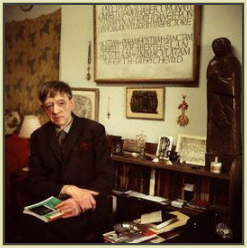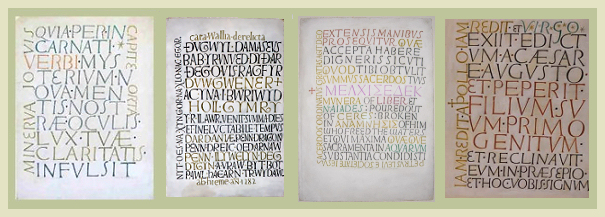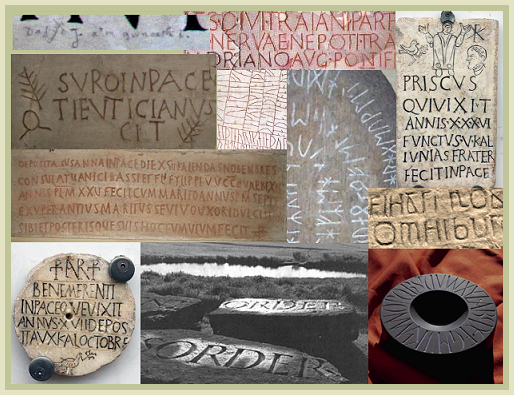|
|
David Jones
Inscriptions a sampling of internet resources
|
|
|
|
See Nicolette Gray's The Painted Inscriptions of David Jones (1980 Gordon Fraser) for further information about the inscriptions. Colin Wilcockson's Mythological References in Two Painted Inscriptions of David Jones provides an in-depth discussion of Jones's approach to his inscriptions while focusing on two particular works. Jonathan Miles and Derek Shiel have a chapter devoted to the inscriptions, "Resonant Abstractions", in their book David Jones: The Maker Unmade, which also places the inscriptions within the context of 20th century abstraction. You'll find such descriptive gems there as:
He was a bard, a 'carpenter of song' and a celebrant. He was a maker of shapes and forms and the inscriptions were often useful artefacts as well as pure art, devotional aids used like 'Mass cards on the altar ... to help him through his daily office'. Jones had bridged the gap between the Ditchling ethos and the more abstract art of his contemporaries and he did it without losing sight of his civilizational predicament, for the letters which make up the inscriptions often appear embattled, a purely formal expression of struggle and loss. [p. 274]
|
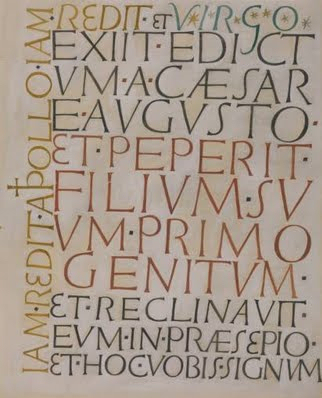
|
Exiit Edictum 1949
Drawing & gouache on paper
support: 406 x 330 mm
From the display caption September 2004:
|
|
|
background and wax crayon technique have been replaced by letters in different colours on white paper; and secondly Jones introduces here his practice of combining fragments from different texts, so as to give visual form to a complex of inter-related meaning. |
||
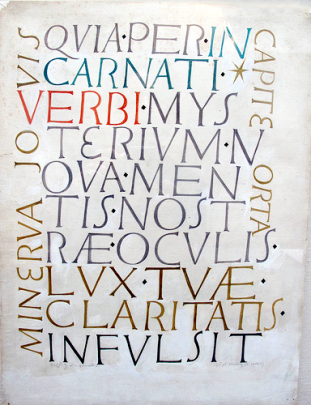
|
1953 Watercolour on paper
500 x 380 mm.
text from Kettle's Yard:
As an explanation Jones wrote on the reverse of the work: "From the Preface of the Mass of the Nativity used from the Midnight Mass of Xmas until the Feast of the Epiphany and was used also, and very appropriately, on the Feats of Corpus Xti
|
|
| until a decree of the Sacred Congregation of Rites for some inexplicable reason, disallowed its use on Corpus Christi some years back, I think in the late nineteen-fifties. This seems very regrettable, because its use on Corpus Xti provided a liturgical link between the Word made Flesh in the stable and what is made present at the Mass. The words round the margin Minerva Jovis capite orta were proposed (I think by one of the Pontiffs in perhaps the sixteenth century, not sure) as expressing the Eternal Generation of the Son from the Father, but the proposition was not found acceptable." | ||
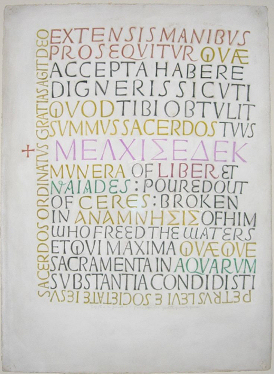
|
Extensis Manibus Prosequitor
1964
Opaque watercolour on an
Jone's work echoes the history of writing on stone and of illuminated texts, such as this sample of Patristic Writing from the
British Library:
|
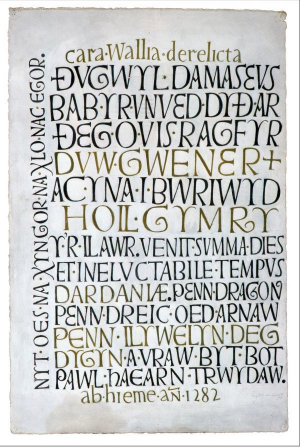
|
|
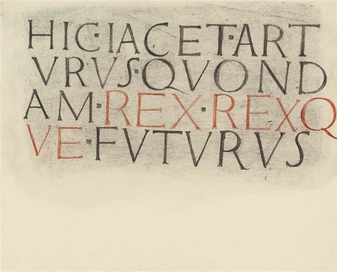
|
Hic Iacet Arturus
(Here Lies Arthur)
Christies
Sale 5391 - 20th Century British Art
from the lot notes:
|
|
|
working on inscriptions for the first time as an art form. The text is from Malory's Morte Darthur 'here lies Arthur, the once and future King'. Jones is seen here experimenting both technically with the use of pencil on wax crayon and also with the letter forms which show an influence of early medieval inscriptions. Hills comments 'He was not, however, I am sure, trying to recreate an historic style, his reaction to the Romano-Celtic connotations of the Arthurian myth was much more personal and complex.' (Exhibition catalogue, David Jones, London, 1981, p. 129).
|
||
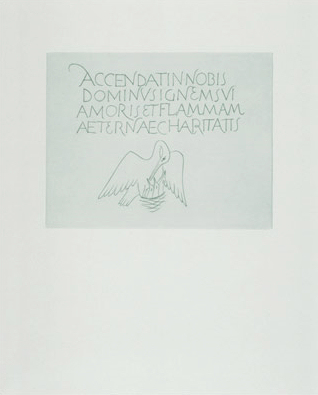
|
Pelican in Her Piety
Engraving
From:
The Rime of the Ancient Mariner 1929
Jones's beautiful modern line echoes an ancient carving from Augurina, 3rd Century
*
|
|
Samples of various inscriptions, from Roman funerary inscriptions to the
|
|
The lovely augurina image was posted by
the calligraphy studio of
|

|
